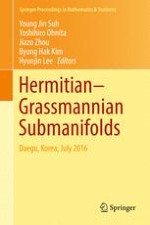2017 | Buch
Hermitian–Grassmannian Submanifolds
Daegu, Korea, July 2016
herausgegeben von: Prof. Young Jin Suh, Prof. Yoshihiro Ohnita, Prof. Jiazu Zhou, Prof. Byung Hak Kim, Dr. Hyunjin Lee
Verlag: Springer Singapore
Buchreihe : Springer Proceedings in Mathematics & Statistics
